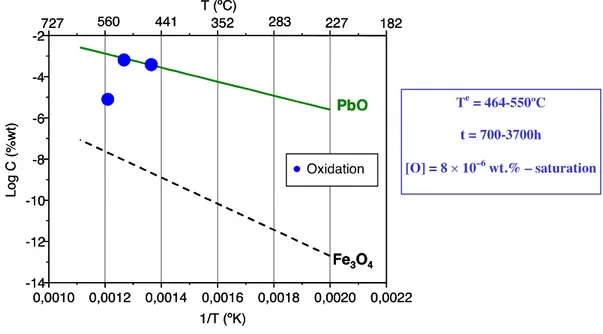1. INTRODUCTION
In the next Generation IV future reactors, one of the concerned issues is the material compatibility and corrosion in liquid Pb, which is considered a candidate coolant. Liquid metal corrosion to the structural materials can proceed via different processes: species dissolution and penetration of liquid metal along grain boundaries and metal. The occurrence of these corrosion phenomenon depend on the experimental parameters, such as temperature, thermal gradients, solid and liquid metal compositions, velocity of the liquid metal and oxygen activity in Pb.
The driving force for corrosion is the difference between the chemical activities of the solute metals between the surface and the LBE. The chemical activity is dependent on the solubility and the chemical activity of the element in the solid phase, which is less than unity for all components in stainless steels. Therefore, the maximum concentration of the solute metal at the boundary of the two phases is determined by its chemical activity in the solid phase.
A general discussion of the different types of corrosion in liquid metals and of the influence of several variables (temperature, temperature gradient, ratio metal solid area to liquid metal volume, velocity and others) can be found in [Staudhammer, 1992], [Bagnall, 1995] [Handbook of HLM, 2007, OECD-NEA].
2. CORROSIONE EXPERIMENTS BACKGROUND
Very few data exist on corrosion in Pb. Experiments have been carried on and published in the frame of DEMETRA EUROTRANS FP VI program, by ENEA. The only available data, at 500°C in oxidizing environment, can be summarized in the following pictures (Fig. 1) taken from the Handbook by OECD NEA.
The existing data base for the corrosion of materials in Pb is very sparse in some areas. Additionally, the actual environment that existed during many of the reported test results is open to question. For example, it would seem to be improbable that dissolution would be the dominant corrosion mechanism for a stainless steel exposed at oxygen potentials near the PbO potential. Lastly, the state of the art of oxygen potential measurement is rapidly improving but for many of the reported test data,
poorly measured. Thus, it is expected that much more data will be needed in the future in order to assure adequate system design. To this end, additional data is required in the following areas:
• Long-term tests (15000 hours) in dynamic conditions to confirm the actual oxygen-temperature areas, especially for austenitic steels to support the design of future systems in which these steels have been chosen as reference.
• Tests in stagnant and flowing lead to expand the database in Pb at high temperature.
• Influence of several parameters (surface state of steels, stresses, welding, etc.) on the corrosion response of steels to improve the knowledge about the dissolution/oxidation process and to support models and mechanisms.
• For high temperature systems (above 550°C), development and testing of advanced materials will be also needed.
The need for high-temperature exposures is connected with incidental conditions. Fuel claddings can reach very high temperatures (up to 1400°C), still exposed to Pb, for randomly short times due to a severe accident, where no in situ oxidation can happen. Such experimental data are totally missing.
Fig. 1 Steels exposed to flowing Pb.
3. PROPOSED TEST MATRIX
According to the abovementioned open points, the followin test matrxi for high temperature tests is proposed:
Material
Duration Experimental conditions
AISI 316L 100 hours, 200 hours,
500 hours.
Stagnant Pb, 700°C; 900°C, 1000°C
15-15 Ti mod(Si) 100 hours, 200 hours, 500 hours. Stagnant Pb, 700°C; 900°C, 1000°C 15-15 Ti mod(Si) FeAl coated (PVD) 100 hours, 200 hours, 500 hours. Stagnant Pb, 700°C; 900°C, 1000°C 15-15 Ti mod(Si) Ta coated (CVD) 100 hours, 200 hours, 500 hours. Stagnant Pb, 700°C; 900°C, 1000°C 15-15 Ti mod(Si) Al2O3 coated (DS) 100 hours, 200 hours, 500 hours. Stagnant Pb, 700°C; 900°C, 1000°C
The exposures will be carried on in a dedicate alumina vessel, inserted into a dedicated oven, in inert atmosphere. Given th every high temperatures, there is no need for Oxygen control, i.e. no scales formation due to unfavourable thermodynamics. After exposure, specimens will undergo SEM EDS imaging.
4. REFERENCES
[1] C. Fazio, I. Ricapito, G. Scaddozzo and G. Benamati, J. Nucl. Mater., 318 (2003) 325-332.
[2] M.Azzati, A.Gessi, G.Benamati, ENEA report, HS-A-R-014, Jan. 2003. [3] I.R.Beattie, T.R.Gilson, J.Chem. Soc., A (1970) 980
[4] C.Fazio, G.Benamati, C.Martini, G. Palombarini, J.Nucl.Mater., 296 (2001) 243-248 [5] G.Muller, A.Heinzel, J.Konys, G.Schunacher, A.Weisenburger, F.Zimmermann,
V.Engelko, A.Rusanov, V.Markov, J.Nucl.Mater., 301 (2002) 40-46
[6] A. Gessi, G. Benamati, G. Scaddozzo, B. Long, M. Azzati, A. Aiello:, J. Nucl Mat., 335 (2004), 169-173
[7] A. Gessi, G. Benamati, G. Scaddozzo, J. Mat. Science, 40 (2005) 1-6. [8] Handbook of HLM, 2007, OECD.NEA

